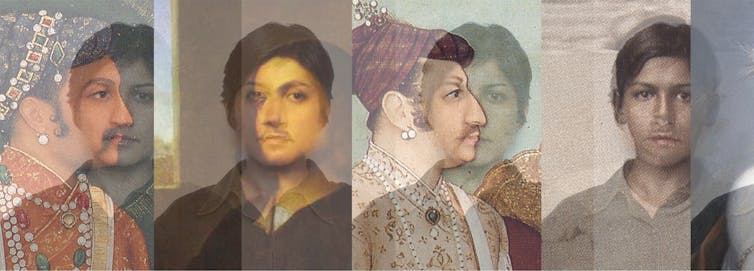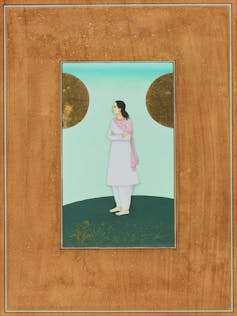
At the Art Gallery of New South Wales, spread across four rooms on the lowest floor of the main building, sits Nusra Latif Qureshi’s first major solo exhibition, Birds in Far Pavilions.
The exhibition is introduced with Did you come here to find history?, a digital print Qureshi created in 2009 for the 53rd Venice Biennale.

The print is nine metres wide and features 17 Mughal and Venetian paintings overlaid with Qureshi’s own passport photograph. The work responds directly to the city of Venice – and history itself – as an “imagined land”.
Placed like a marquee leading towards the show’s interior, it suggests the exhibition asks this question, too. Did you come here to find history? The inquiry, Qureshi explains, refers in part to “the relationship of artist with art history”.
That the exhibition plays with scale is fitting for an artist who was trained in musaviri, or Mughal miniature painting, at the National College of Arts in Lahore, Pakistan.
In Descriptions of past II (2001), golden plants sway beneath a woman’s feet.

You’d need a magnifying glass to appreciate the blades of grass emerging from the ground like pieces of hair, rendered as finely as the woman’s own wavy strands.
An installation on the far wall in the first room, Shafts in ground (2015), combines maps of the Costerfield antimony mines in Victoria with some everyday wares from a prospector’s camp.
In Qureshi’s hands, the room, with its yawning ceilings and empty centre, toys with its own sparseness. Visitors are compelled to hew close to the works along the walls, skimming the edges as though in orbit of nothing. Such is Qureshi’s and curator Matt Cox’s command of the space.
The choice befits how the artist toggles with space in her works, which sometimes fill the boards on which they are rendered, and at other times yield to swathes of coloured ground.

Qureshi moved to Melbourne from Lahore in 2001 – from one former city of the British empire to another. This colonial comparison undergirds, but does not determine, her subsequent works.
At the exhibition’s heart is the Museum of lost memories (2024), in which Qureshi has gathered objects from the Art Gallery’s collection, the Powerhouse Museum and her own studio.
In several crowded display cases, she has placed Australian souvenirs, Mughal paintings, photographs, polo mallets and Indian daggers. Objects that speak to the museum’s encyclopaedic remit turn to converse with those from Qureshi’s own studio – a doily, a stone Bodhisattva, a textile, a plastic tank.
In the 19th century, musaviri painters repurposed their skills and began hand-colouring photographs. An old label tells us one photograph’s subject, embellished in deep blue, is a Shia Muslim from Sindh.

Leaning into the past
Qureshi’s work is as much art as it is art history. History and, by extension, historical art, seem to have become bad objects in Australia.
Perhaps to answer the neoliberal university’s obsession with KPIs, as well as the Australian government’s “job-ready” policy, art history has turned to the present to proclaim its relevance. Curators and artists present imagined futures and reparative gambits that obscure or sit alongside historical material.
These interventions are important, but if they are not matched by a rigorous and nuanced engagement with history, then historical objects become the tarnished relics of a benighted past. Relatedly, contemporary works become flattened into one or another critical posture.
This progressivist vision of history makes a villain of the past and a hero of the present.
But there are no perfect heroes or villains in Qureshi’s works. Or, if there are, they are strikingly adjacent – and only two among many strands of an ever-unfolding history.
Her paintings are often described for their layered effects. In Justified behavioural sketch (2002), the carmine outlines of British army officers with polo mallets resemble the rugged boundaries of maps as they invade a woman’s face.
This same outline forms the third diptych in the Accomplished missions series (2012), here slightly covered by an open, green hand.

In Gardens of Desire (2002), a botanical drawing from Scottish illustrator Sydney Parkinson is laid gently over Radha and her lover, the god Krishna.
From layers to threads
Over time, however, Qureshi’s layered lines have turned to string. Threads are animate and wayward, limp and tangled, in the Conference of birds series (2013). The same gossamer strings envelop and stabilise two acrobats in On the edges of darkness II (2016).

More recently, these strings have been brought into the world. We see them draped above and through Qureshi’s paintings of 19th and early 20th century portrait photographs from Melbourne in Refined portraits of desire (2018).
Red yarn spills from ringlet curls and feathered hats, connecting the oval paintings on the wall to one another and to corresponding works on a table below.

In the Museum of lost memories, bits of string and cord drape and adjoin objects like red, deflated roads. And in The room with red tiles (2023) – pictured in the header image above – hands gather and pass cascading thread down the length of a green ground.
Qureshi is pulling on things that may never untangle, but it is the pulling that matters. Her art draws together objects and images that resist resolution – looping the present into a past that continues to unravel.
In her work, we are bound to the past and to one another with pieces of scattered threads, should we choose to follow them.
Ariel Kline does not work for, consult, own shares in or receive funding from any company or organisation that would benefit from this article, and has disclosed no relevant affiliations beyond their academic appointment.
This article was originally published on The Conversation. Read the original article.







